BY JEFF PRITCHARD
The purchase of a vacuum furnace involves a considerable capital investment. As a result, the question of buying a used furnace at a lower cost than a new furnace is a fairly common one. However, there are a number of potential issues with used equipment that should underscore the warning “buyer beware”. To begin with, good used vacuum furnaces are a rare commodity. When they do appear on the market, they don’t last long. Many of the best are purchased through industry networking and never reach the general market. Still, there are numerous dealers of used furnace equipment with inventories posted on their websites.
Most used furnaces are sold on an as-is, where-is basis with no manufacturer’s warranty. If a decent used candidate is located, there are a few very important items to investigate before purchasing. One of the biggest and most difficult to detect problems with used furnaces is the condition of the water jacket in the vacuum chamber. The life of a properly maintained vacuum chamber can be well over twenty years. However, in situations where the furnace cooling system has been connected to an untreated water supply, water jacket blockages from mineral build-up can begin to appear in as little as three years. Beyond dissecting the vacuum chamber, there are no fool-proof methods for detecting blockages. Ultrasonic testing is sometimes used but can be expensive and unreliable. The presence of blistered or discolored paint on the outside of the chamber is a good indication of hot spots due to blockage. Perhaps the best approach is to avoid altogether used furnaces more than twenty years old. If water jacket blockage problems arise after purchase, the only sure solution is re-lining the chamber at considerable time and expense.
 The condition of the hot zone in a used furnace is far easier to assess. A thorough visual inspection is usually all that is needed. Distorted, discolored or crumbling insulation, warped or broken elements or hearth rails, missing element insulators and other damaged hardware are all signs that restoration work is required. All-metal hot zones tend to deteriorate faster than graphite-based hot zones and are often more expensive to repair. In the worst cases, complete replacement of the hot zone might be required. For a medium-sized furnace, a replacement hot zone can cost $50,000 or more.
The condition of the hot zone in a used furnace is far easier to assess. A thorough visual inspection is usually all that is needed. Distorted, discolored or crumbling insulation, warped or broken elements or hearth rails, missing element insulators and other damaged hardware are all signs that restoration work is required. All-metal hot zones tend to deteriorate faster than graphite-based hot zones and are often more expensive to repair. In the worst cases, complete replacement of the hot zone might be required. For a medium-sized furnace, a replacement hot zone can cost $50,000 or more.
The vintage of the control system is another item that should be evaluated. While computer-based control systems can operate reliably for many years, the most popular manufacturers of controllers and other instrumentation tend to limit the periods in which they support their products. So even if a controller is only ten years old it may be very difficult to procure spare parts in the event of a failure.
When considering all of these factors, it is simple to conclude that buying a new vacuum furnace is much safer than buying used. However, if the upfront cost is the primary factor in the new versus used purchase decision, expect to pay one half to two-thirds of the price of a new furnace for a decent used unit. Contact VAC AERO if restoration work is required. VAC AERO also deals in quality used equipment when available.
For more information on VAC AERO’s Furnace and Upgrades click here
